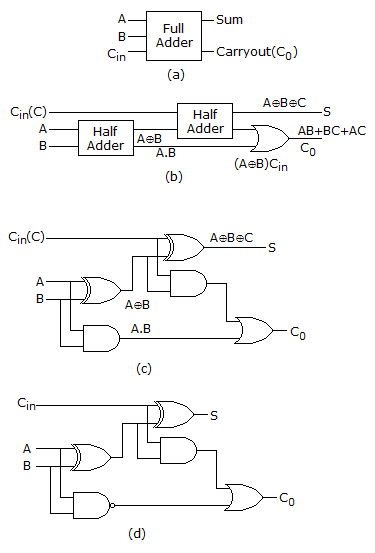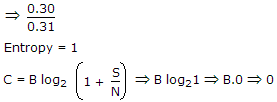Discussion
Home ‣ Electronics and Communication Engineering ‣ Microwave Communication See What Others Are Saying!
- Question
Impedance level of Impatt diodes is generally lower than that of Gunn diodes
Options- A. True
- B. False
- Correct Answer
- True
ExplanationAn Impatt diode has n+ - p - i - p + structure and is used with reverse bias.It exhibits negative resistance and operates on the principle of avalanche breakdown.
Impatt diode circuits are classified as broadly tunable circuit, low Q circuit and high Q circuit.
The impedance of Impatt diode is a few ohms. The word Impatt stands for Impact Avalanche Transit Time diode.
The features of Impatt diode oscillator are : frequency 1 to 300 GHz, Power output (0.5 W to 5 W for single diode circuit and upto 40 W for combination of several diodes), efficiency about 20%.
Its applications include police radar systems, low power microwave transmitter etc.
More questions
- 1. A parallel plate capacitor having C = 200 x 10-12 F has loss dielectric having tan ? = 4 x 10-4. At an ac voltage of f = 106 Hz and peak value 2 V, the dielectric losses are
Options- A. 10-8 W
- B. 10-6 W
- C. 10-4 W
- D. 10-2 W Discuss
Correct Answer: 10-6 W
Explanation:
Dielectric losses = v2 ?C tan ?.- 2. A full adder can be made out of
Options- A. two half adders
- B. two half adders and a OR gate
- C. two half adders and a NOT gate
- D. three half adders Discuss
Correct Answer: two half adders and a OR gate
Explanation:

- 3. A reflex klystron oscillator is a
Options- A. low power device
- B. high power device
- C. high efficiency device
- D. both (a) and (b) Discuss
Correct Answer: low power device
Explanation:
It uses a single cavity resonator for generating microwave oscillations.Its parts are electron gun, resonator, repeller and output coupling.
It operates on the principle of positive feed back.
The repeller electrode is at negative potential and sends the partially bunched electron beam back to resonator cavity.
This positive feedback supports oscillations. Its feature are:
1. Frequency range - 2 to 100 GHz
2. Power output - 10 MW to about 2 W
3. Efficiency - 10 - 20 %
Its applications include radar receivers, local oscillator in microwave devices, oscillator for microwave measurements in laboratories etc.
- 4. A wave is propagated in a waveguide at frequency of 9 GHz and separation is 2 cm between walls Calculate group velocity for dominant mode.
Options- A. 1.8 x 108 m/sec
- B. 5 x 108 m/sec
- C. 3 x 108 m/sec
- D. 1.5 x 108 m/sec Discuss
Correct Answer: 1.8 x 108 m/sec
Explanation:
Vg . Vp = C2where

 .
.
- 5. The number of layers in a Shockley diode are
Options- A. 2
- B. 3
- C. 4
- D. 2 or 3 Discuss
Correct Answer: 4
- 6. The speed transducer using a drag cup rotor has the main advantage of
Options- A. very high accuracy
- B. low energy requirement
- C. cheap construction
- D. all of the above Discuss
Correct Answer: low energy requirement
Explanation:
A drag cup rotor has low inertia. Therefore it requires little amount of energy.- 7. When the channel is noisy, producing a conditional probability of error p = 0.5; the channel capacity and entropy function would be, respectively,
Options- A. 1 and 1
- B. 1 and 0.5
- C. 0.5 and 1
- D. 0 and 1 Discuss
Correct Answer: 0 and 1
Explanation:

 .
.
- 8. Assertion (A): If source and destination addresses are made implicit the length of instruction is reduced.
Reason (R): 8085 has only 3 addressing modes.
Options- A. Both A and R are correct and R is correct explanation of A
- B. Both A and R are correct but R is not correct explanation of A
- C. A is correct R is wrong
- D. A is wrong R is correct Discuss
Correct Answer: A is correct R is wrong
Explanation:
The number of addressing modes is five.- 9. An electrolytic capacitor can be used for
Options- A. ac only
- B. dc only
- C. both ac and dc
- D. high frequency ac Discuss
Correct Answer: dc only
- 10. In a backward wave oscillator the wave
Options- A. travelling along the line winds itself back and forth
- B. progresses only in forward direction
- C. progresses only in backward direction
- D. either (a) or (c) Discuss
Correct Answer: travelling along the line winds itself back and forth
Explanation:
It is somewhat similar to TWT and can deliver microwave power over a wide frequency band.It has an electron gun and a helix structure. However the interaction between electron beam and RF wave is different than in TWT.
The growing RF wave travels in opposite direction to the electron beam.
The frequency of wave can be changed by changing the voltage which controls the beam velocity.
Moreover the amplitude of oscillations can be decreased continuously to zero by changing the beam current.
It features are:
1. Frequency range - 1 GHz to 1000 GHz.
2. Power output - 10 mV to 150 mW (continuous wave) 250kW (pulsed).
It is used as signal source in transmitters and instruments.
Comments
There are no comments.
More in Electronics and Communication Engineering:
Programming
Copyright ©CuriousTab. All rights reserved.
